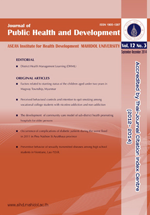Determinants of incomplete immunization among hill tribe children aged under two years in Myanmar
Main Article Content
Abstract
Immunization coverage is still a major concern in many third world countries especially in remote areas. In Myanmar, the hill tribe region is regarded as one of vulnerable, tangible outreach areas. The immunization coverage in mountainous areas were quite low compared to other areas of Myanmar. A cross-sectional study was conducted to examine the immunization status of children under two years of age, to describe factors towards incomplete immunization, and to determine the association between the factors and incomplete immunization of children under two years of age. Multi-stage stratified sampling was used to enroll a total of 330 respondents in rural and urban areas of the rocky regions. Mothers who has under two years old child were interviewed by trained health staffs. Chi-square test and multiple logistic regression were applied to determine factors associated with immunization.
The results indicated that one-fourth (25.8%) of children had incomplete immunization. The incomplete immunization prevalence was high in urban areas (57.6%) and rural areas (42.4%). After adjusting for confounding factors, the results showed that occupation (AOR=2.18, 95%CI=1.27-3.76), perception (AOR=2.37, 95%CI=1.01-5.56), place of vaccination (AOR=2.63, 95%CI=1.53-4.51) and the person sent for vaccination (AOR=2.40, 95%CI =1.33-4.35) were significantly (P-value < 0.05) associated with incomplete immunization
and the strongest predictor was volunteer help (AOR=3.15, 95%CI =1.47-6.76).
In conclusion, the accessibility of immunization services is still in demand to increase immunization coverage in mountainous zones in Myanmar. It is also revealed that the role of volunteers need to be strengthened for enhancement of immunization coverage. Health information among ethnic groups should be in dialect for better understanding about the benefits of immunization.


